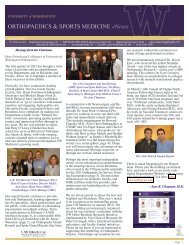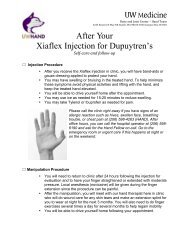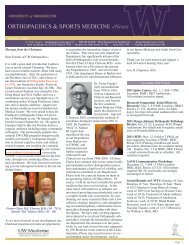2002 - University of Washington Bone and Joint Sources
2002 - University of Washington Bone and Joint Sources
2002 - University of Washington Bone and Joint Sources
Create successful ePaper yourself
Turn your PDF publications into a flip-book with our unique Google optimized e-Paper software.
etween the head (at the center <strong>of</strong><br />
gravity) <strong>and</strong> the sternum was reduced<br />
from about 48 mm to 20 mm.<br />
Measurements indicated lower peak<br />
accelerations <strong>and</strong> less variation in<br />
subject responses with the modified<br />
head restraint.<br />
Computer modeling<br />
MADYMO (Mathematical<br />
Dynamic Modeling, TNO Automotive,<br />
Delft Netherl<strong>and</strong>s) is used in the<br />
automotive industry for design <strong>of</strong> safety<br />
devices. It simulated the motion <strong>of</strong> the<br />
occupant modeled as rigid bodies (the<br />
bones) connected by joints, with<br />
properties well defined by cadaveric<br />
testing. The seat was modeled as a finite<br />
element object based on mechanical<br />
testing <strong>of</strong> the seat frame <strong>and</strong> cushion.<br />
Using this approach allowed the<br />
internal forces in the cervical spine to<br />
be defined since the model includes<br />
individual vertebrae <strong>and</strong> their<br />
connecting s<strong>of</strong>t tissues. Responses at<br />
impact speeds much higher than<br />
tolerable by volunteers were studied.<br />
Also, various properties <strong>of</strong> the seat were<br />
altered <strong>and</strong> the response <strong>of</strong> the<br />
occupant determined.<br />
The response <strong>of</strong> the model in terms<br />
<strong>of</strong> acceleration <strong>of</strong> the head <strong>and</strong> chest<br />
fell well within the responses measured<br />
in the volunteer studies described<br />
above. As shown in Figure 3, with a<br />
head restraint that reaches the top <strong>of</strong><br />
the occupant’s head <strong>and</strong> an initial gap<br />
<strong>of</strong> about 4 inches, the major force acting<br />
is shear, that is a horizontal force across<br />
the spinal vertebrae. With the head<br />
initially upright <strong>and</strong> momentarily<br />
stationary, while the torso is thrust<br />
forward by its contact with the seatback,<br />
an anterior shear or horizontal force<br />
acts on the cervical spine. Later, as the<br />
torso is stopped by the shoulder strap<br />
<strong>and</strong> the head is thrust forward by its<br />
contact with the head restraint, a<br />
secondary shear force develops.<br />
Reducing the head to restraint distance<br />
did not significantly alter these forces.<br />
It did prevent extension <strong>of</strong> the cervical<br />
spine <strong>and</strong> head but instead created<br />
greater flexion during the forward<br />
rebound <strong>of</strong> the head. Making the seat<br />
<strong>and</strong> head restraint s<strong>of</strong>ter decreased the<br />
magnitude <strong>of</strong> the primary shear force<br />
<strong>and</strong> reduced the head rebound from the<br />
restraint by absorbing energy, therefore<br />
decreasing the secondary shear force.<br />
Cadaveric Studies<br />
In order to gain insight into the<br />
detailed deformations <strong>of</strong> cervical spine<br />
tissues, a series <strong>of</strong> 11 cadaveric cervicothoracic<br />
specimens with an<br />
instrumented artificial skull was tested.<br />
Each specimen was mounted onto a<br />
platform, replacing the seat, on the<br />
same cart used for human volunteer<br />
testing. The same head restraint was<br />
used <strong>and</strong> the impactor was adjusted so<br />
that the acceleration at vertebra T1<br />
(about top <strong>of</strong> sternum level) was similar<br />
to that recorded by volunteers. High<br />
speed video was used to film the<br />
positions <strong>of</strong> markers on the lateral<br />
masses <strong>and</strong> the vertebral bodies <strong>and</strong><br />
measurements were made <strong>of</strong> the<br />
contact pressures in the facet joints, <strong>and</strong><br />
around the nerve roots. The effect <strong>of</strong><br />
the modified head restraint was<br />
studied.<br />
Figure 4 showed formation <strong>of</strong> a<br />
partial “S” curvature, specifically<br />
extension <strong>of</strong> the lower cervical spine<br />
which seemed to be most prominent<br />
when the head motion was stopped by<br />
the head restraint. Following rebound<br />
from the head restraint the spine was<br />
subjected to both anterior shear <strong>and</strong><br />
tensile forces as the head moved<br />
forward <strong>of</strong> the lower spine.<br />
Reproducible pressure pulses occurred<br />
around the nerve roots, highest at levels<br />
C7-T1, <strong>and</strong> were maximum after peak<br />
acceleration <strong>of</strong> the chest but before peak<br />
acceleration <strong>of</strong> the head occurred.<br />
Pressure measurements in the facets<br />
showed pinching (a high pressure point<br />
in the joint instead <strong>of</strong> a uniform<br />
contact), in about 70% <strong>of</strong> tests, with<br />
C4-5 <strong>and</strong> C5-6 having the greatest<br />
likelihood <strong>of</strong> pinching. The modified<br />
head restraint reduced head<br />
acceleration <strong>and</strong> resulting spinal shear<br />
forces by about 30%.<br />
CONCLUSION<br />
In a rear-end vehicle impact, even<br />
when the occupant’s head is positioned<br />
close to the head restraint, significant<br />
forces can be developed in the cervical<br />
spine with resulting intervertebral<br />
displacements <strong>and</strong> tissue pressures <strong>and</strong><br />
deformations. These forces are a<br />
primary anterior shear, due to the torso<br />
being thrust under the stationary head<br />
by its contact with the seat, <strong>and</strong> a<br />
secondary force from the head being<br />
thrust forward by its contact with the<br />
head restraint as the torso motion stops.<br />
The basic method for reducing spinal<br />
forces <strong>and</strong> intersegmental<br />
displacements is to s<strong>of</strong>ten the torso-toseat<br />
<strong>and</strong> head-to-restraint contact, <strong>and</strong><br />
importantly, use the head restraint to<br />
absorb the energy <strong>of</strong> these impacts.<br />
RECOMMENDED READING<br />
Insurance Institute for Highway Safety<br />
“Whiplash Injuries”, Status Report,<br />
30:no 8, pp1-12, Sept 16, 1995.<br />
Tencer AF, Mirza SK, Bensel K, The<br />
response <strong>of</strong> human volunteers to rearend<br />
impacts, The effect <strong>of</strong> head<br />
restraint properties, Spine, 26: Nov,<br />
2001.<br />
Tencer AF, Mirza SK, Bensel KD,<br />
Internal loads in the cervical spine<br />
during motor vehicle rear-end impacts:<br />
The effect <strong>of</strong> acceleration <strong>and</strong> head-tohead<br />
restraint proximity, Spine, 27: Jan,<br />
2001.<br />
Tencer AF, Mirza SK, Cummings, P, Do<br />
whiplash victims with neck pain differ<br />
from those with neck pain <strong>and</strong> other<br />
symptoms Proceedings <strong>of</strong> the<br />
Association for the Advancement <strong>of</strong><br />
Automotive Medicine, Sept, 2001.<br />
Ono, K, Kaneoka K, Wittek, A, Kajzer J,<br />
Cervical injury mechanism based on<br />
the analysis <strong>of</strong> human cervical vertebral<br />
motion <strong>and</strong> head-neck-torso<br />
kinematics during low speed rear<br />
impacts, Transactions <strong>of</strong> the Society <strong>of</strong><br />
Automotive Engineers, 973340, 1997.<br />
Yogan<strong>and</strong>an, N, Pintar FA, Cusick, J,<br />
Biomechanical analyses <strong>of</strong> whiplash<br />
injuries using experimental models,<br />
Proceedings <strong>of</strong> the World Congress on<br />
Whiplash <strong>and</strong> Associated Disorders,<br />
Vancouver, BC, Feb, 1999, pp 325-344,<br />
1999.<br />
Deng B, Begeman PC, Yang KH,<br />
Tashman S, King AI, Kinematics <strong>of</strong><br />
human cadaver cervical spine during<br />
low speed rear-end impacts, STAPP Car<br />
Crash Journal, 44:171-188, 2000.<br />
24 <strong>2002</strong> ORTHOPAEDIC RESEARCH REPORT















